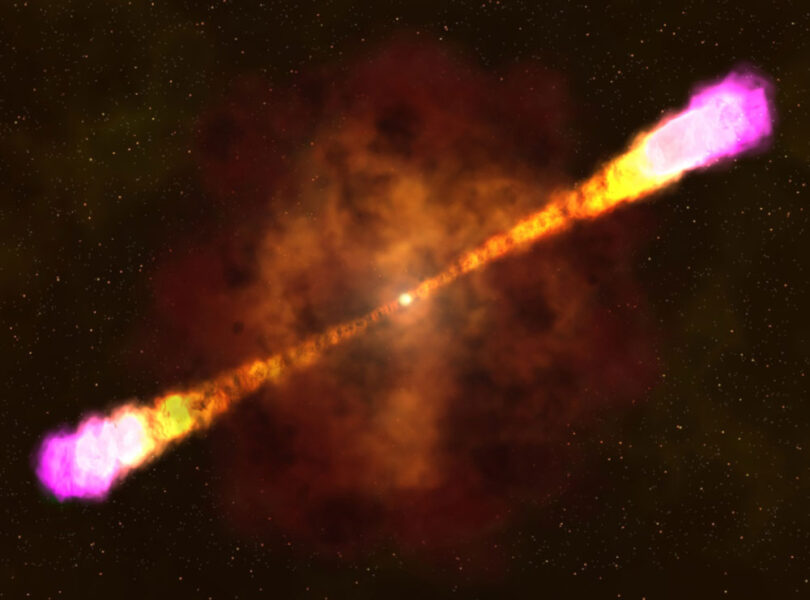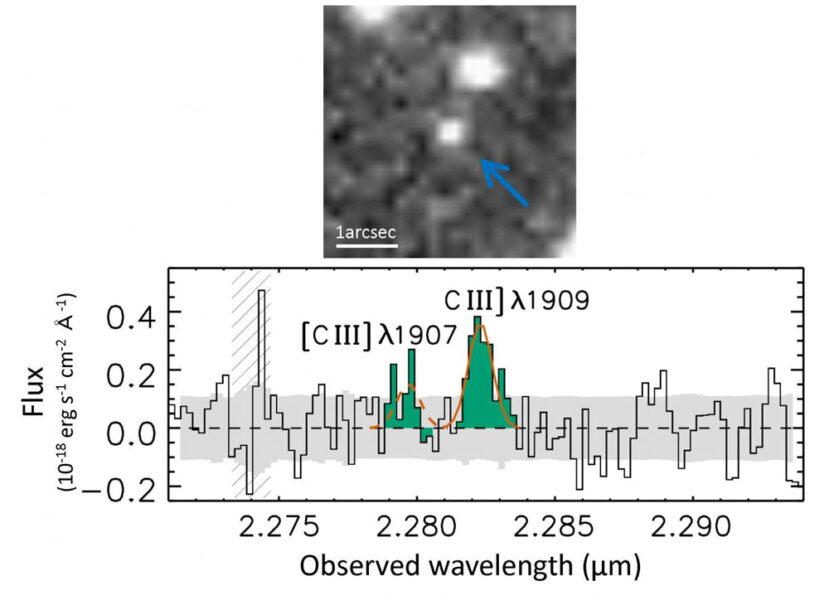From the farthest-known galaxy in the observable universe comes the brightest and most energetic of events: a possible gamma-ray burst.

NASA / GSFC
In March 2016, astronomers found a galaxy, called GN-z11, that was more distant — and therefore more ancient — than any seen before. This full-grown galaxy’s light originated just 420 million years after the Big Bang, when the Milky Way was still in its infancy.
Reporting observations in Monday’s Nature Astronomy, a team based out of Beijing confirms the extreme distance. Not only did they measure a more precise age, but they also found something unexpected, which the report in a second study published in the same journal. Over their five-hour period of observation using the Keck Telescope in Hawai‘i, the astronomers observed a brief, luminous spike of ultraviolet light from GN-z11.
“We noticed that one of the images had a bright burst in the exact position of the galaxy,” says study lead Linhua Jiang (Peking University). “It was surprising, because the object is so faint. The only way we could have seen it is if we were looking right there, at that moment, because a few minutes later, it was gone.”
Jiang and his colleagues suggest that this unexpected UV flash might have been the afterglow of a gamma-ray burst (GRB), produced when very massive stars collapse.
Before this, the youngest-known GRB was one that went off 520 million years after the Big Bang. Younger events are out of range for GRB hunters such as NASA’s Neil Gehrels Swift Observatory and Fermi Gamma-ray Space Telescope.
Origin of the Flash
It’s entirely possible that the telltale flash didn’t actually originate from GN-z11. It could have come from something that transited between Earth and the galaxy at exactly the right moment, like a cosmic photobomb. The team considered all the likely culprits: satellites, asteroids, stellar flares, even a coincidental GRB in a closer galaxy. In the end, their calculations suggested that it was highly unlikely that the flash came from anywhere other than GN-z11.
As for the source of the emission, the researchers rule out a supernova or tidal disruption event. Those can last for days or longer, and what the team saw was there and gone in less than three minutes. In other words, the spectrum, brightness, and duration of the transient were consistent with a GRB.
Péter Mészáros (Penn State University), who was not involved in the study, agrees that the spectrum is what he would expect from a GRB. “This is potentially a very important discovery,” he says.
Probing Cosmic Dawn
Gamma-ray bursts are thought to be created by the collapse of massive stars, and given that GN-z11 existed so shortly after the Big Bang, it would be tempting to think that such an early GRB could represent the death of one of the first generation of stars, known as Population III stars. ““But what’s really interesting,” says team member Bing Zhang (University of Nevada, Las Vegas), “is that we saw some strong carbon lines, meaning this is a second-generation star.”

Kashikawa et al. / University of Tokyo
The universe began with only hydrogen and helium and a smattering of lithium. Heavier elements like carbon had to be fused in the cores of massive stars and distributed when they exploded. So if there is carbon in GN-z11, the galaxy must already be in the second stage of its stellar evolution — even at the fresh young age of only 400 million years old.
Unfortunately, UV observations alone are not enough to identify the flash as a GRB without a doubt. The chance that another telescope was looking in that exact part of the sky at that exact moment are slim to none.
Beyond pushing the limits of detectability, confirming the age of GN-z11, and providing evidence of Population II stars at only 400 million years after the Big Bang, this discovery is also an exciting glimpse at the future: Next-generation instruments like the James Webb Space Telescope should reliably detect much higher-redshift objects, perhaps even finding a Population III star or two. Until then, our attempts to probe the dawn of the universe must continue to rely on serendipity.
 0
0









Comments
You must be logged in to post a comment.